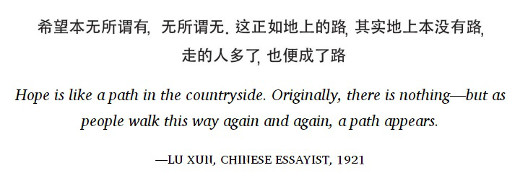John Locke? Lu Xun? Anonymous?
Question for Quote Investigator: The following statement appears on many websites:
As people are walking all the time, in the same spot, a path appears.
The words are usually attributed to the English philosopher John Locke or the Chinese writer Lu Xun. I have been unable to find a citation. Would you please explore this topic?
Reply from Quote Investigator: In 1986 “The Burning Forest: Essays on Chinese Culture and Politics” was published by Simon Leys, the pen name of the critic and essayist Pierre Ryckmans. The following passage was printed in the appendix and credited to Lu Xun. A footnote stated that the sayings of Lu Xun were translated from Chinese by Simon Leys:1
HOPE
Hope can be neither affirmed nor denied. Hope is like a path in the countryside: originally there was no path—yet, as people are walking all the time in the same spot, a way appears.
The 2014 citation given further below presented an alternative translation. QI, at this time, has found no support for crediting John Locke with the expression given by the questioner.
Here are additional selected citations in chronological order.
In 1995 the book “Being Human in the Ultimate: Studies in the Thought of John M. Anderson” included an instance of the saying attributed to Lu Xun. The accompanying footnote pointed to a 1921 collection of essays which QI has not examined. Boldface has been added to excerpts:2
The image of an unending journey here evoked is echoed in the picture of hope sketched by the Chinese novelist Lu Xun:
…it is like a path in the countryside: originally there was no path—yet, as people are walking all the time in the same spot, a way appears. 8
Footnote 8: Lu Xun, Essays (San Francisco: New China Press, 1921).
In 1996 the saying was printed in the scholarly journal “Daedalus” with a supporting endnote that pointed to “The Burning Forest” by Simon Leys which has already been discussed:3
Their hope was neither grandiose nor eloquent. Rather, in the words of Lu Xun, they doggedly stayed on the path, even where there was none: “Hope can be neither affirmed nor denied. Hope is like a path in the countryside: originally there was no path—yet, as people are walking all the time in the same spot, a way appears.”
By 2009 the saying was being credited to John Locke. For example, a compilation called “Quote Junkie: Philosophy Edition” included the following entry:4
As people are walking all the time, in the same spot, a path appears.
John Locke
An instance of the saying appeared as an epigraph at the beginning of the 2014 book “A Path Appears: Transforming Lives, Creating Opportunity” by Nicholas D. Kristof and Sheryl WuDunn. The words were presented in Chinese and in English:5
Hope is like a path in the countryside. Originally, there is nothing—but as people walk this way again and again, a path appears.
—LU XUN, CHINESE ESSAYIST, 1921

A note at the end of the book discussed the source of the epigraph. The translation was crafted by the authors although the rendering by Simon Leys in “The Burning Forest” was acknowledged as an influence:
Our translation is not a literal one, since the first part is difficult to express in idiomatic English. It reflects the idea that hope can’t be said fundamentally to exist or not exist in any metaphysical sense; rather, it is created by our actions, just as we create a path in the countryside. Hope, he is saying, depends on us.
In conclusion, QI believes that this saying should be credited to Lu Xun. The Chinese version in “A Path Appears: Transforming Lives, Creating Opportunity” seems to be the most accurate that QI has seen. The translation into English is not easy, and the 1986 and 2014 citations offered different versions. The linkage to John Locke was unsupported.
Acknowledgement: Great thanks to Christina Davis whose inquiry led QI to formulate this question and perform this exploration.
Update History: On January 18, 2025 the format of the bibliographical notes was updated.
- 1986, The Burning Forest: Essays on Chinese Culture and Politics by Simon Leys (Pierre Ryckmans), Section: Appendixes: Some Sayings of Lu Xun, (Footnote states that the sayings were translated from the Chinese by Simon Leys), Start Page 215, Quote Page 223, Published by Holt, Rinehart, and Winston, New York. (Verified on paper) ↩︎
- 1995, Being Human in the Ultimate: Studies in the Thought of John M. Anderson, Volume 23, Series: Value Inquiry, Editors: N. Georgopoulos and Michael Heim, Chapter: Horizon of Freedom, Quote Page 73, (Footnote 8 is on Page 83), Publisher: Rodopi, Amsterdam, The Netherlands and Atlanta, Georgia. (Google Books Preview) ↩︎
- 1996 Winter, Daedalus: Social Suffering, Volume 125, Number 1, The Pane of Sorrow: Public Uses of Personal Grief in Modern China by Vera Schwarcz, Start Page 119, Quote Page 144, Published by The MIT Press on behalf of American Academy of Arts & Sciences. (JSTOR) link ↩︎
- 2009, Quote Junkie: Philosophy Edition, Quote Page 83, Hagopian Institute: President Todd Hagopia. (Google Books Preview, Amazon Look Inside) ↩︎
- 2014, A Path Appears: Transforming Lives, Creating Opportunity by Nicholas D. Kristof and Sheryl WuDunn, Epigraph on Page vii, Note on Page 337, A Borzoi Book, Alfred A. Knopf, New York. (Amazon Look Inside, Kindle Preview) ↩︎